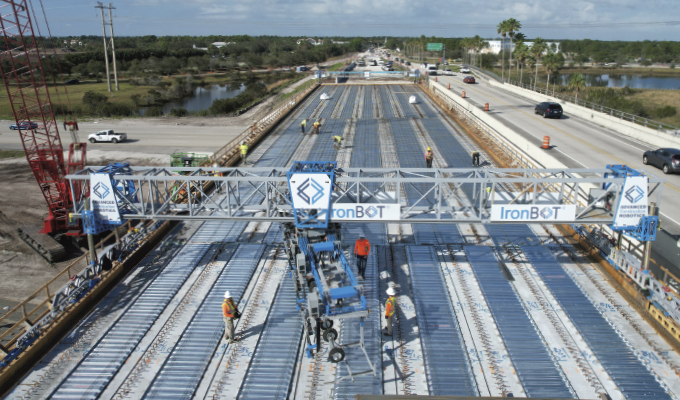The Port St. Lucie West Boulevard bridge needed widening as it is a key access point to the I-95 Corridor in eastern Florida. The bridge project is part of a $15.5 million effort that includes a new 3-lane eastbound bridge over I-95 to accommodate projected future traffic volumes. And, with tens of thousands of vehicles using it every day, it couldn’t be shut down for construction for an extended period of time.
Shelby Erectors, the subcontractor for Cone & Graham Heavy Construction doing the bridge rebar construction, knew the rebar installation robots developed by Advanced Construction Robotics (ACR) would be the ideal solution to the limited window of time available. Shelby Erectors already had extensive experience as an Integration Partner with ACR and was trained on and became skilled at using their rebar tying robot, TyBOT. Incorporating ACR’s newest robot, IronBOT, to lift, carry, and place the rebar, was the next logical step.
CHALLENGES
Port St. Lucie West Boulevard is a key access point on the I-95 Corridor in eastern Florida for people and cargo headed to and from the Miami-West Palm Beach metro area. The Florida Department of Transportation’s traffic volume counts show that nearly 50,000 cars and trucks use the boulevard each day. Finding a way to minimize closures and disruptions to traffic was a challenge for this project.
Another issue was finding enough people qualified to do the work. The entire construction industry is facing a shortage of skilled workers, including rodbusters. Associated Builders and Contractors estimates that an additional 500,000 workers are needed to meet current jobsite demands in 2024 alone. According to their report, there are several differing factors contributing to the qualified worker gap, including higher than normal retirement rates due to baby boomers, public and private megaprojects tying up large numbers of the available workforce, and low interest in construction careers among young people.
To overcome these challenges, Shelby Erectors knew they could complete the job more efficiently by augmenting their crew with the help of ACR’s modern tools of the trade, TyBOT and IronBOT.
SOLUTION
Shelby Erectors had already been boosting crew productivity with TyBOT for over two years, which made their crew a rational choice for employing TyBOT and IronBOT. “We were excited to be able to have IronBOT and TyBOT work together alongside our crew on this project. We were impressed that we could slash our rebar installation schedule in half while keeping the same crew. We are actively looking for new projects to incorporate both TyBOT and IronBOT in our operations,” says Jack Nix, COO of Shelby Erectors, Inc.
Port St. Lucie West Boulevard was the first time a project combined the rebar lifting/placing power of IronBOT with the rebar tying power of TyBOT to deliver remarkable savings to construction projects using rebar. IronBOT, ACR’s newest robot, literally does the heavy lifting for you. IronBOT augments construction crews by lifting, carrying, and placing up to 5,000-lb bundles of rebar in a transverse or longitudinal orientation. TyBOT takes care of the repetitive, backbreaking task of tying rebar intersections so crews can focus on more complex work. Onsite and working within hours, TyBOT self-locates, self-positions, and self-ties more than 1,200 intersections per hour, day or night, rain or shine, while improving jobsite safety.
Nix also understood that part of the solution was the willingness of the contractor, Cone & Graham, to use the robot pair on this project. “We were looking for a contractor like Cone & Graham that was willing to let us do that, to bring TyBOT and IronBOT out to the jobsite and to take a chance on doing something different, something new,” Nix says. “It’s a great partnership. We value our partnership with Cone & Graham.”
RESULTS
With IronBOT lifting, carrying, and placing rebar, and TyBOT tying the intersections on the Port St. Lucie project, the crew observed a rebar installation schedule savings of 50 percent with shifts reduced to seven from a projected 14. By augmenting Shelby’s crew with ACR’s robots, the same amount of work was completed in only seven days. During the project, IronBOT placed 130,952 lbs. of rebar and TyBOT completed 32,668 ties over 6.5 production shifts. TyBOT and IronBOT completed their work in February 2023.
“When you’re incorporating new technology into your project, it’s really about the marathon, not the sprint,” Nix says. “You’ve got to be able to see the big picture, because qualified tradesmen are hard to find, and that’s probably not going to change anytime soon. You have to update your thinking as to what the modern crew looks like. ACR’s rebar robots are the best way to augment your existing crew with technology. It allows us to do the same job with fewer people and do it faster and safer. It worked out well because we were ready to roll with IronBOT, and we were already using TyBOT. We are on the forefront of robotic technology in rebar construction, especially when it comes to these bridge decks.”
“I am so excited to see our initial prediction of cutting schedules by at least 50 percent come to fruition on IronBOT’s maiden voyage,” says Danielle Proctor, CEO of Advanced Construction Robotics. “This was a perfect example of how field teams, working alongside our technology, can form a ‘modern crew’ to unleash disruptive productivity levels. This robotic revolution provides innovative construction firms the ability to become game-changers by adopting and putting their modern crew to work.”
For More Information
Advanced Construction Robotics is a world-leading innovator of autonomous robotic equipment, transforming the construction industry by filling the skilled labor gap and increasing overall productivity. For more, visit www.constructionrobots.com.


